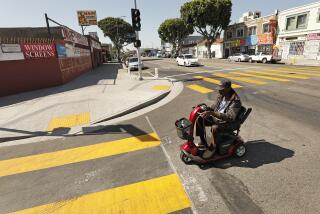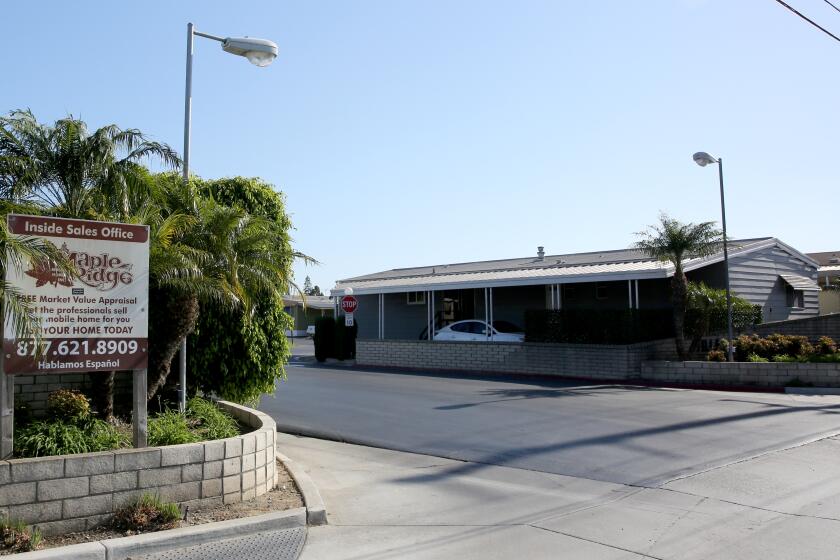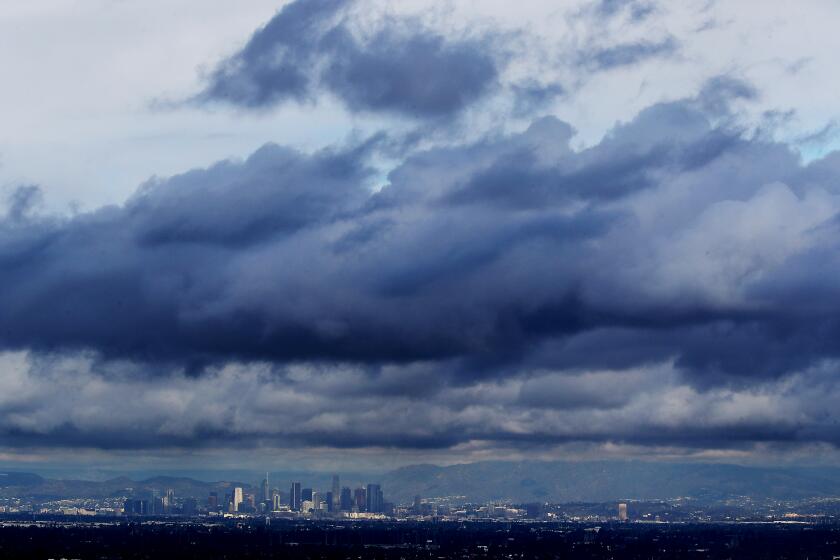Red-light cameras catch right turns and lots of revenue
- Share via
Porcia London walked into the West Los Angeles courthouse ready to fight her red light camera ticket.
Unlike some drivers facing fines, the 29-year-old homemaker had not risked a deadly broadside by sailing through a stop light -- the principal safety problem cameras were intended to address. Her $159 citation came after she braked at a Manchester Avenue intersection, checked for cross traffic and made a right turn.
“I looked to make sure,” she said. “I wasn’t being unsafe.”
In Los Angeles, officials estimate that 80% of red light camera tickets go not to those running through intersections but to drivers making rolling right turns, a Times review has found. As London realized that day in court, her turn was illegal because she did not completely stop before turning.
One of the most powerful selling points for photo enforcement systems, which now monitor 175 intersections in Los Angeles County and hundreds more across the United States, has been the promise of reducing collisions caused by drivers barreling through red lights.
But it is the right-turn infraction -- a frequently misunderstood and less pressing safety concern -- that drives tickets and revenue in the nation’s second-biggest city and at least half a dozen others across the county.
Some researchers and traffic engineers question the enforcement strategy.
“I’ve never . . . seen any studies that suggest red light cameras would be a good safety intervention to reduce right-turning accidents,” said Mark Burkey, a researcher at North Carolina A&T; State University who has studied photo enforcement collision patterns.
Some county cities with photo enforcement opt not to target right turns. Others limit camera use for those citations.
“We’re kind of very leery about right turns. . . . They’re not really unsafe per se,” said Pasadena’s senior traffic engineer, Norman Baculinao. Only one of that city’s seven camera-equipped intersection approaches is set up to monitor right-turn violations, he said.
“This is intended to be a traffic safety program. People who make right turns generally are going at a low speed,” and resulting accidents tend to be a “sideswipe at most,” he said.
Emphasizing those violations, Baculinao said, would be “more for revenue generation” than safety.
Federal Highway Administration research has found that cameras can reduce red light violations and broadside crashes but can also increase less serious rear-end accidents caused by people making sudden stops to avoid tickets. Thus far, the studies have focused solely on straight-through and left-turn crashes because they are the most serious and common, said Doug Hecox, an agency spokesman.
Right-turn collisions are a “considerably rarer thing . . . [and] tend to have less likelihood of a fatality or serious injury,” he said.
Officials in Los Angeles and other cities that cite large percentages of right-turn violators -- Covina, South Gate, Lancaster, Baldwin Park, Walnut and Montebello -- say the infractions increase hazards, particularly for pedestrians. “People have this misconception that it’s OK to whip a right turn on a red light,” said Los Angeles County Sheriff’s Deputy Jon White, with Lancaster’s photo enforcement program.
Right turns at red lights have “always been associated with some danger,” said transportation researcher Richard Retting of the Insurance Institute for Highway Safety. “Enforcing against drivers who don’t stop at all has the potential to make intersections safer.”
Cities choose which intersection approaches and movements -- left turn, straight through, right turn or a combination -- they want cameras to track, often after reviewing accident and violation data. Many cities record illegal right turns only when a vehicle is going 15 mph or faster.
The city of Los Angeles issued more than 30,000 photo tickets last year at 32 camera-equipped intersections. About eight in 10 involved right turns, said Los Angeles Police Sgt. Matthew MacWillie, the program’s co-coordinator.
Improper right turns had not caused a major accident problem, said Glenn Ogura, a city traffic engineer. But they reflect bad driver habits.
“They could actually hit a pedestrian,” he said. “We’ve been lucky, [but] it’s certainly, for us, a very real safety problem.”
Twenty-three of the county’s 88 cities -- along with Los Angeles County and the Metropolitan Transportation Authority -- have installed red light camera systems. All red light running violations in Los Angeles County carry a hefty $381 penalty -- with one notable exception.
Tickets for improper right turns at traffic signals in the city of Los Angeles carry a fine of only $159.
Other agencies insist that they are ticketing properly, but MacWillie said the LAPD practice is long-established and appropriate.
“When you’re doing 40 miles per hour on a straight-through violation, the likelihood of causing a serious or fatal [crash] is much greater,” MacWillie said. During right turns, “most people have control of their vehicle. . . . If they see another vehicle or pedestrian, you’re able to react and stop in time.”
Montebello officials say their city’s camera program -- which involves mostly right-turn tickets -- is about safety, not money.
Still, Superior Court estimates show that Montebello’s cameras have one of the county’s highest revenue-generating rates, bringing in about $90,000 per month from five approaches to three intersections.
On a per-approach basis, that is three to four times the amounts collected in some cities, where officials say photo ticket revenues have declined and basically cover system costs. At this point, Montebello’s camera program brings in about two times its expenses.
In the eastern San Gabriel Valley, Walnut’s cameras cover two approaches at a single intersection: Grand Avenue and Amar Road. Other movements are monitored, but the bulk of tickets issued are for right turns, said Los Angeles County Sheriff’s Sgt. Brad Gray.
Walnut’s system netted about $250,000 in 2007, its first year of operation, said Chuck Robinson, assistant to the city manager. Right-turn enforcement was included, records and interviews show, after camera vendor Redflex Traffic Systems surveyed several intersections and set a “threshold” of violations needed to make the cameras financially feasible.
“It had to meet that,” Robinson said, and right-turn violations helped.
A Redflex spokeswoman said the company takes “absolutely no position” on whether right turns should be cited. Robinson said violations are down, which is the goal.
Some experts caution that violation rates aren’t necessarily the best measure of intersection hazards or improvements.
“From an engineering standpoint, we know the locations we would want are different than what the [camera] vendor would want,” said Stephen Yanez, a Downey engineer. “They are basically looking for locations that have a high violation rate. We are looking for locations with a high collision rate. . . . Collision rate is not necessarily related to violation rate.”
Using cameras to police right turns offers a “tremendous opportunity for revenue” because the violation is common, he said. But he added that the turns involve relatively little accident risk.
“That’s why people are doing it,” he said. Downey turned down a red light camera proposal because of uncertainty about the effects on traffic safety and revenue, records show.
Motorists often are confused and complain about right-turn photo tickets, police say. John Jasso, a Pasadena technology manager, said he didn’t fully get the complete-stop rule until two right-turn photo tickets came in the mail a week apart.
One was before sunrise on a Saturday morning. The streets were largely deserted, he recalled, as he braked and rounded a corner heading to the Montebello golf course.
The second ticket, before the first arrived in the mail, involved another early trip to a golf course, he said.
“I was like, ‘They’ve got to be kidding me.’ Especially at 6 in the morning,” he said. The first ticket cost him $381; the second was dismissed because of a paperwork error, he said.
Jasso thinks focusing cameras on right turns is mostly about generating cash.
But he admits it changed how he approaches signalized corners.
“Now I stop every single time,” he said. “No matter what time of day or night.”
--
--
Begin text of infobox
Measuring effectiveness
How effective are red light cameras in reducing collisions?
* In 2005, a federal study of seven jurisdictions across the country found a 25% reduction in broadside crashes and a 15% increase in rear-end collisions related to drivers making sudden stops. Partly because broadsides are more serious, the Federal Highway Administration concluded that cameras can be effective when they are carefully placed and when driver reaction is monitored.
* A city of Los Angeles analysis in 2006 found a 10% to 15% reduction in red light-running accidents.
* Santa Clarita reported a roughly 64% drop in red light-running accidents, from an average of 1.7 to 0.61 per intersection per year. Rear-end accident data were unavailable, but traffic officials believe that collisions have not increased much.
* Cerritos reported that red light-running crashes decreased between 41% and 52%. Rear-end crashes rose between 24% and 45%.
Source: Federal Highway Administration and Times reporting by Rich Connell
Los Angeles Times
More to Read
Sign up for Essential California
The most important California stories and recommendations in your inbox every morning.
You may occasionally receive promotional content from the Los Angeles Times.










